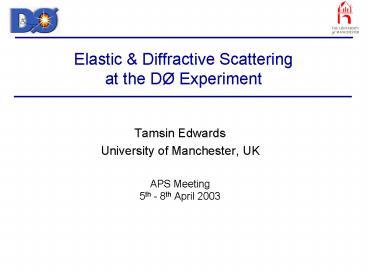Elastic - PowerPoint PPT Presentation
1 / 12
Title:
Elastic
Description:
Main part of D experimental analysis: ... primed layers offset from unprimed - read out by PMTs. 6th April 2003. T.Edwards APS Meeting ... – PowerPoint PPT presentation
Number of Views:49
Avg rating:3.0/5.0
Title: Elastic
1
Elastic Diffractive Scatteringat the DØ
Experiment
- Tamsin Edwards
- University of Manchester, UK
- APS Meeting5th - 8th April 2003
2
Hadron scattering at the Tevatron
The Tevatron accelerator collides protons and
antiprotons at a centre-of-mass energy of vs
1.96 TeV at an average rate of 1.7 MHz
- 60 of total pp cross-section is Inelastic
Scattering - p and p break up
- Main part of DØ experimental analysis
- rare hard scale processes production of jets,
W/Z bosons, b top quarks etc
3
Elastic Scattering
Elastic scattering events
- p and p scatter with no momentum loss
- beam particles remain intact, scattered at very
small angle - no other particles produced
What could be passed between p and pthat
transfers momentum without either breaking up?
Exchanged object must have certain properties
- no charge
- no colour (colour-singlet)
quantum numbers of the vacuum
Dominantly exchanged object at high energies
given the name Pomeron
- structure not well understood
4
Elastic Scattering
- Colour-singlet exchange
- gives rise to absence of particles or energy
above threshold in some region of rapidity a
Rapidity Gap
- rapidity pseudorapidity ? - ln tan (?/2)
- where ? is angle of particle with respect to
beam
The experimental view of the Pomeron is the
thing that causes rapidity gaps
Elastic scattering event
5
Diffractive Scattering
- Diffractive Scattering takes some momentum
Single Diffractive Scattering
Double Pomeron Exchange
- To use perturbative predictions, look at hard
diffractive processes - jets, heavy particles also produced
6
Rapidity Gaps
- Finding rapidity gaps
- Calorimeter
- liquid-argon/uranium
- Luminosity Monitors (LM)
- scintillators close to beam pipe
Triggers for gap events
- single gap triggers
- 1 jet with pT gt 25 GeV
- gap south no hits in south LM
- gap north no hits in north LM
- double gap trigger
- 1 jet with pT gt 25 GeV
- no hits in either LM
Analysing rapidity gaps
Look at energy in forward region of calorimeter
- how much energy is deposited close to beam pipe
on the gap side? - on the non-gap side?
7
Energy in forward calorimeter
Sum of energy of cells above threshold (100MeV)
in first four layers of calorimeter
(electromagnetic) in forward/backward regions
South 2.6 lt ? lt 4.1
North - 4.1 lt ? lt -2.6
North
South
Gap North events
EM Energy (Gev)
EM Energy (Gev)
Shows expected diffractive behaviour peak at
very low energy on gap side
8
The Forward Proton Detector
- FPD measures track of scattered p or p in
magnetic field to determine momentum and
scattering angle
D - Dipole magnet, bends beam around ring Q -
Quadrupole magnets, focus beam S - Separators,
bring beams together to collide
Antiproton Quadrupolespectrometers
Proton Quadrupolespectrometers
Dipolespectrometer
9
The Forward Proton Detector
- Each spectrometer consists of 2 Roman Pots,
- vessels containing scintillating fiber tracking
detector
Proton Up quadrupolespectrometer
Detector
- U, U diagonal wires
- X, X horizontal wires
- trigger scintillator
- V, V opposite diagonal wires
- primed layers offset from unprimed - read out
by PMTs
10
The Forward Proton Detector
With momentum measurement we can obtain
- Momentum fraction taken by the pomeron, ?
- elastic ? 0
- pomeron exchange dominates for ? lt 0.05
where pi(f) inital (final)momentum
- Four-momentum transfer, t
- t ?2, where ? is scattering angle
Much more information is available with FPD than
with gap analysis alone
Acceptance
- Dipole requires sufficient momentum loss for
proton to be bent into detector
all t
? gt 0.04
- Quadrupole requires sufficient scattering angle
t gt 0.8 GeV2
all ?
11
FPD Preliminary Results
Preliminary plots
? and t for elastic scattering events
Expected elastic behaviour
- ? 0
- exponential t distribution
?
t (GeV2)
12
Summary
- Many types of interesting events hard double
pomeron exchange, diffractive production of
jets, W/Z bosons, heavy quarks... - previous papers from UA8, Hera, DØ Run I have
driven current experimental interest
- Gap analysis can already tell us a lot about
these events
- Forward Proton Detector will tell us even more































